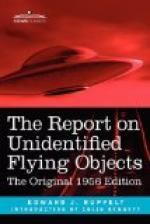At 12,000 feet I stopped climbing, but the light was still climbing faster than I was. I then reversed my turn from left to right and the light also reversed. As I was not gaining distance, I held a steady course south trying to estimate a perpendicular between the light and myself. The light was moving north, so I turned north. As I turned, the light appeared to move west, then south over the base. I again tried to intercept but the light appeared to climb rapidly at a 60- degree angle. It climbed to 35,000 feet, then started a rapid descent.
Prior to this, while the light was still at approximately 15,000 feet, I deliberately placed it between the moon and myself three times to try to identify a solid body. I and my two crewmen all had a good view of the light as it passed the moon. We could see no solid body. We considered the fact that it might be an aerologist’s balloon, but we did not see a silhouette. Also, we would have rapidly caught up with and passed a balloon.
During its descent, the light appeared to slow down at about 10,000 feet, at which time I made three runs on it. Two were on a 90-degree collision course, and the light traveled at tremendous speed across my bow. On the third run I was so close that the light blanked out the airfield below me. Suddenly it started a dive and I followed, losing it at 1,500 feet.
In this incident the UFO was a balloon.
The following night a lighted balloon was sent up and the pilot was ordered up to compare his experiences. He duplicated his dogfight— illusions and all. The Navy furnished us with a long analysis of the affair, explaining how the pilot had been fooled.
In the case involving the ground observer and the F-47 near the atomic installation, we plotted the winds and calculated that a lighted balloon was right at the spot where the pilot encountered the light.
In the other instance, the “white object with two windows,” we found that a skyhook balloon had been plotted at the exact site of the “battle.”
Gorman fought a lighted balloon too. An analysis of the sighting by the Air Weather Service sent to ATIC in a letter dated January 24, 1949, proved it. The radioactive F-51 was decontaminated by a memo from a Wright Field laboratory explaining that a recently flown airplane will be more radioactive than one that has been on the ground for several days. An airplane at 20,000 to 30,000 feet picks up more cosmic rays than one shielded by the earth’s ever present haze.
Why can’t experienced pilots recognize a balloon when they see one? If they are flying at night, odd things can happen to their vision. There is the problem of vertigo as well as disorientation brought on by flying without points of reference. Night fighters have told dozens of stories of being fooled by lights.
One night during World War II we had just dumped a load of bombs on a target when a “night fighter” started to make a pass at us. Everyone in the cockpit saw the fighter’s red-hot exhaust stack as he bore down on us. I cut loose with six caliber-.50 machine guns. Fortunately I missed the “night fighter”—if I’d have shot it I’d have fouled up the astronomers but good because the “night fighter” was Venus.




